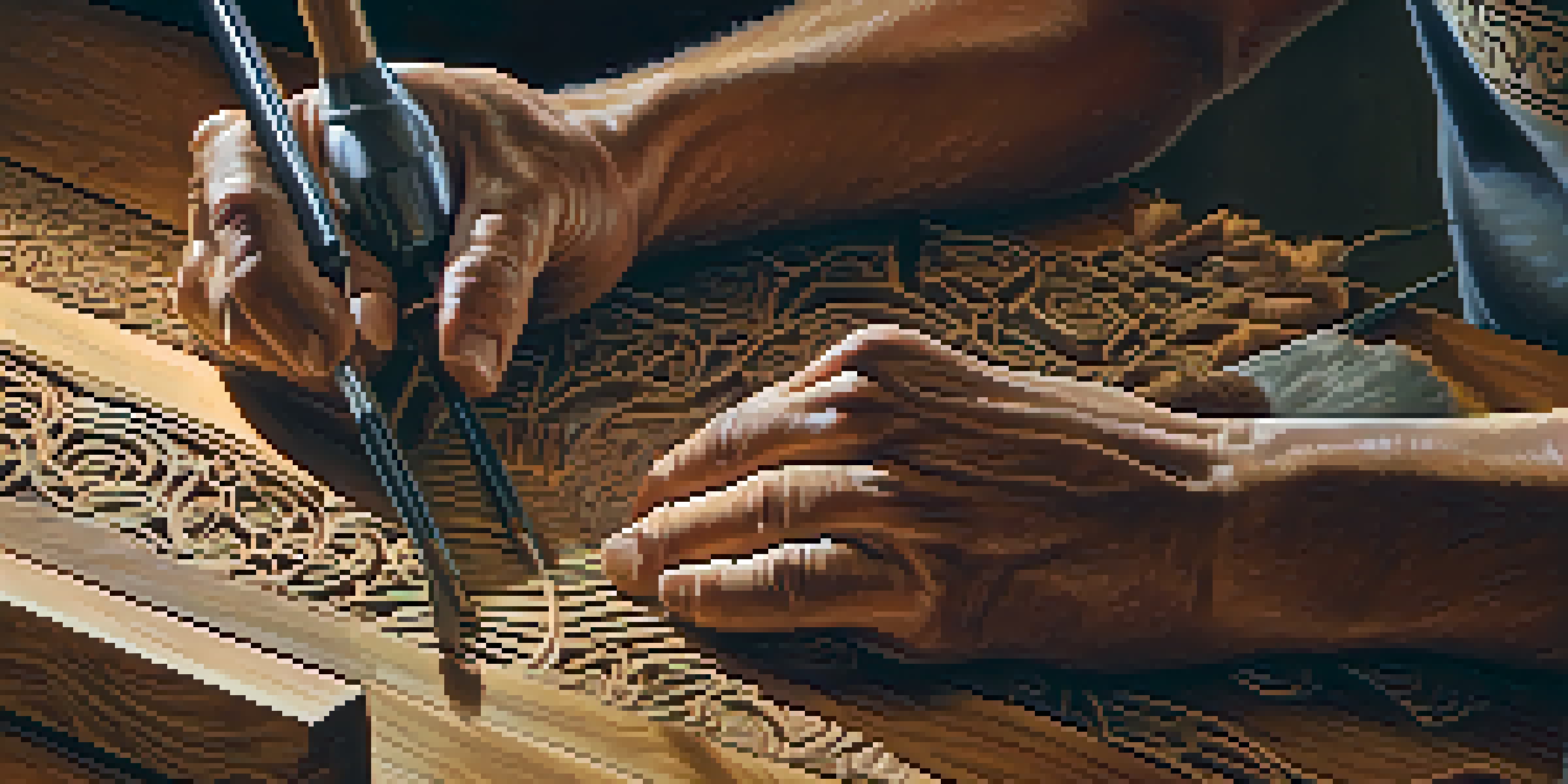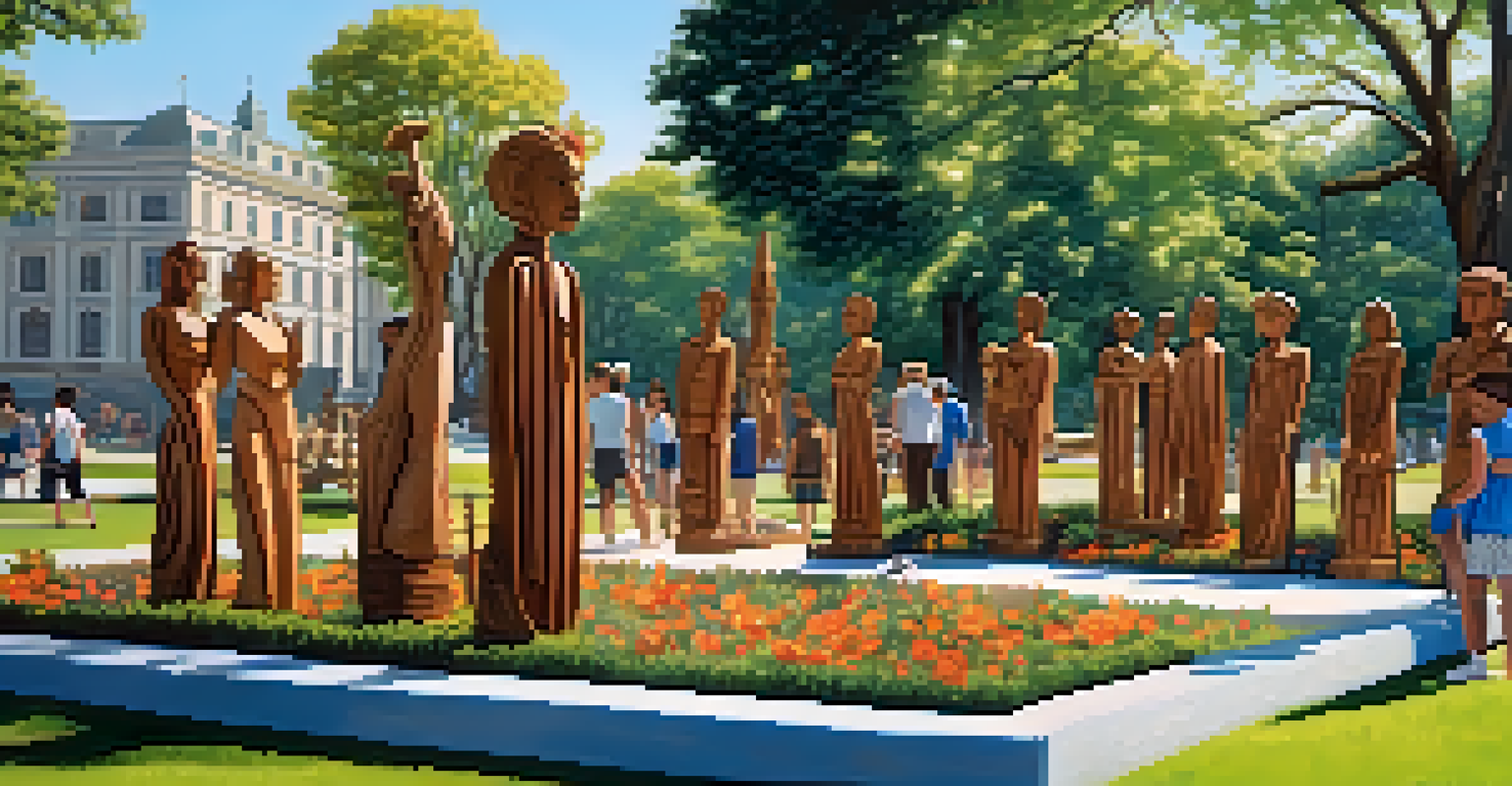The Role of Traditional Carving in Modern Community Art

Understanding Traditional Carving and Its Roots
Traditional carving is an ancient art form that involves shaping materials like wood, stone, or bone into intricate designs. This craft not only reflects the cultural heritage of a community but also tells stories passed down through generations. Each carved piece is often imbued with symbolism, representing the values and beliefs of the people who create them.
Art is not a thing; it is a way.
In many cultures, traditional carving was not just an artistic endeavor but also a means of preserving history. For instance, Indigenous tribes in North America used carving to depict their legends and significant events. By understanding the roots of this craft, we can appreciate its profound relevance in contemporary society.
As modern artists seek inspiration, traditional carving serves as a bridge connecting the past to the present. It invites us to explore how these age-old techniques can be adapted and integrated into today's artistic expressions, ultimately enriching community art initiatives.
The Revival of Traditional Carving in Community Art Projects
In recent years, there has been a noticeable revival of traditional carving within community art projects. Artists are increasingly recognizing the value of incorporating these techniques into their work, creating a fusion of old and new. This revival not only breathes life into traditional methods but also helps in the collective healing and identity-building of communities.

Local workshops and collaborative carving sessions have emerged, inviting community members to participate in the art-making process. These initiatives not only foster creativity but also instill a sense of pride and ownership among participants. It's inspiring to see people of all ages come together, sharing their stories and experiences through the medium of carving.
Revival of Carving in Communities
Traditional carving is experiencing a revival through community art projects that foster creativity and collective identity.
Moreover, this communal approach helps keep traditional carving alive and relevant. By engaging younger generations, artists are ensuring that these skills and stories are passed down, allowing them to adapt and evolve in today's ever-changing artistic landscape.
Enhancing Cultural Identity Through Carving
Traditional carving plays a crucial role in enhancing cultural identity within modern communities. As artists delve into their heritage, they often find themselves rediscovering techniques and motifs that resonate deeply with their roots. This connection fosters a sense of belonging and pride that is essential for a thriving community.
The artist is not a special kind of person; every person is a special kind of artist.
For example, many African communities use carving to express their unique cultural narratives, often incorporating symbols that represent their history and values. By showcasing these elements in public art installations, communities can celebrate their identity while educating others about their traditions.
Thus, traditional carving becomes a form of storytelling that transcends time and space. It reinforces community bonds and encourages dialogue between generations, allowing for a richer understanding of cultural heritage in a modern context.
The Role of Technology in Modern Carving Practices
While traditional carving techniques are invaluable, technology is playing an increasingly important role in modern practices. Artists are now using digital tools to design and visualize their carvings before the physical work begins. This blend of tradition and innovation allows for greater experimentation and creativity.
For instance, computer-aided design (CAD) software can help artists plan intricate designs, ensuring precision and efficiency. Subsequently, techniques like CNC (computer numerical control) milling can be employed to bring these designs to life, merging traditional craftsmanship with modern technology.
Cultural Identity Through Art
Traditional carving enhances cultural identity by allowing communities to express their unique narratives and values.
This marriage of old and new not only broadens the scope of what can be created but also attracts a younger audience to the art form. By showcasing how technology enhances traditional carving, artists can emphasize the relevance of these practices in today's digital age.
Community Engagement Through Collaborative Carving
Collaborative carving projects are an effective way to engage community members and foster connections. When people come together to create, they share their experiences, ideas, and skills, leading to a richer artistic product. These projects often result in public art pieces that reflect the community's collective identity and spirit.
An example of this can be seen in community-driven sculptures that incorporate input from various local artists and residents. Each individual's contribution not only enhances the final piece but also ensures that it resonates with a larger audience. This process creates a sense of shared ownership and pride in the completed work.
Moreover, these collaborations can serve as platforms for social change, addressing issues that matter to the community. By tackling themes of unity, diversity, and resilience through their carvings, artists can spark meaningful conversations and inspire action.
Educational Opportunities in Traditional Carving
Educational initiatives centered around traditional carving provide valuable opportunities for skill development and cultural appreciation. Workshops and classes can be tailored to different age groups and skill levels, ensuring that everyone has a chance to learn. Such programs not only teach the intricacies of carving but also highlight its historical significance.
For instance, schools that incorporate traditional carving into their arts curriculum can foster a deeper understanding of cultural heritage among students. By learning about the stories and symbolism behind the carvings, students develop a greater respect for their community's history and identity.
Technology's Role in Carving
Modern technology, like CAD and CNC, is enhancing traditional carving practices, allowing for greater creativity and precision.
Furthermore, these educational opportunities can empower individuals to explore their artistic potential. As they gain confidence in their skills, they may contribute to community projects or even develop their own unique styles, ensuring the continuation of traditional carving for future generations.
Looking Ahead: The Future of Traditional Carving in Art
As we look to the future, the role of traditional carving in modern community art is poised to grow even more significant. With increasing interest in sustainable and locally-sourced art forms, traditional carving offers an eco-friendly alternative that respects materials and craftsmanship. Artists are likely to explore new ways to incorporate these techniques into contemporary practices while preserving their essence.
Moreover, the digital age presents both challenges and opportunities for traditional carving. As artists navigate the fine line between innovation and tradition, there is potential for a richer dialogue about the meaning of art in our rapidly changing world. This exploration can lead to exciting collaborations that blend various artistic styles and mediums.

Ultimately, the future of traditional carving in community art will depend on the willingness of artists and communities to embrace both their heritage and the possibilities that lie ahead. By championing these practices, we can ensure that the stories and skills of traditional carving continue to inspire and unite us for generations to come.